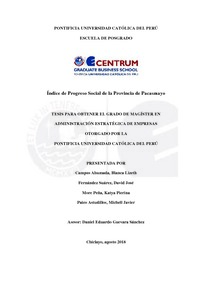| dc.contributor.advisor | Guevara Sánchez, Daniel Eduardo | |
| dc.contributor.author | Campos Ahumada, Blanca Lizeth | es_ES |
| dc.contributor.author | Fernández Suárez, David José | es_ES |
| dc.contributor.author | More Peña, Katya Pierina | es_ES |
| dc.contributor.author | Paico Astudillos, Michell Javier | es_ES |
| dc.date.accessioned | 2018-09-20T22:09:28Z | |
| dc.date.available | 2018-09-20T22:09:28Z | |
| dc.date.created | 2018 | |
| dc.date.issued | 2018-09-20 | |
| dc.identifier.uri | http://hdl.handle.net/20.500.12404/12682 | |
| dc.description.abstract | El Perú ha obtenido en los últimos años un crecimiento económico a tasas moderadas
y seguirá registrando una aceleración de su actividad económica, de acuerdo a la Comisión
Económica para América Latina y el Caribe (CEPAL, 2017); sin embargo, este crecimiento
económico no se refleja en un bienestar social y ambiental de sus ciudadanos (D’Alessio y
Arribas, 2016). Desde el año 2013, se vienen realizando mediciones del índice de progreso
social (IPS) a nivel de países, regiones y ciudades. En nuestro país por primera vez se ha
realizado un estudio del IPS de la provincia de Pacasmayo, que permite evidenciar las
diferencias y similitudes que pueden existir entre los cinco distritos que la componen: (a)
Guadalupe, (b) Jequetepeque, (c) Pacasmayo, (d) San José y (e) San Pedro de Lloc.
Para medir el progreso social de la provincia de Pacasmayo se utilizó la metodología
desarrollada por el Social Progress Index (SPI), cuyas dimensiones aplicadas fueron: (a)
necesidades básicas, (b) fundamentos de bienestar y (c) oportunidades. La investigación fue
de carácter cuantitativo, no experimental y transversal. Se accedió a información primaria a
través de encuestas, e información secundaria a través de la consulta en base de datos
digitales de entidades estatales, para luego validar esta información obtenida utilizando los
métodos estadísticos propios de la herramienta.
Los resultados obtenidos en el IPS de la provincia de Pacasmayo se presentan a nivel
distrital: un promedio de 63.94 puntos, calificado como un nivel medio bajo según la escala
del SPI, resultado que mantiene consistencia con el IPS 2016 de la región La Libertad de
58.75. Las principales diferencias están en la dimensión de necesidades humanas básicas,
donde la provincia se encuentra 25 puntos por encima de la región, a diferencia de las
dimensiones de fundamentos de bienestar y oportunidades, donde la provincia se encuentra 4
y 5 puntos debajo, respectivamente. A nivel distrital, resalta el distrito de Jequetepeque que
obtuvo el mayor puntaje con 71.76, encontrándose en un nivel medio alto. Los distritos de Pacasmayo (63.31), San Pedro de Lloc (62.00), San José (61.96) y Guadalupe (60.68) se
encuentran en un nivel medio bajo. | es_ES |
| dc.description.abstract | Peru has obtained economic growth at moderate rates in recent years and will
continue to record an acceleration of its economic activity, according to the Economic
Commission for Latin America and the Caribbean. However, this economic growth is not
reflected in social welfare and environmental needs of their citizens. Since the year 2013, the
world has been measuring the Social Progress Index (SPI) in countries, regions, and cities.
This is the first time that the Social Progress Index has been done in the Province of
Pacasmayo. During the study we will compare similaries and differences gathered from its
five districts: (a) Guadalupe, (b) Jequetepeque, (c) Pacasmayo, (d) San Jose and (e) San
Pedro de Lloc.
To measure the Social Progress in Pacasmayo province, they have utilized a
consistent methodology created by the Social Progress Index (SPI), the index combines three
dimensions which are: (a) basic needs, (b) Foundations of Well-being and (c) opportunity.
The research consisted on collecting quantitative data, no experimental and using a transverse
method. We have accessed primary information obtained through surveys, as well as
secondary information obtained through digital data shared by governmental entities. This
information obtained then was validated using statistical methods.
The results obtained during the SPI in Pacasmayo province has been presented in a
district level obtaining an average of 63.94 points which falls under “Medium Low” level,
according to the SPI scale. The results were consistent with the SPI done in 2016 in La
Libertad Region which 58.75 points were obtained. The main differences when measured
Basic Human Needs Pacasmayo (Province) was 25 points more than La Libertad (Region),
on the other hand in regards to the Foundations of Well being and Opportunity the province
was four to five points below in comparison with the region. Jequetepeque is the city that
shine itself with the highest ranking with 71.76 points, in the “Medium high” level. Districts of Pacasmayo (63.31), San Pedro de Lloc (62.00), San José (61.96) y Guadalupe (60.68) falls
under “Medium Low” according to the SPI scale. | es_ES |
| dc.language.iso | spa | es_ES |
| dc.publisher | Pontificia Universidad Católica del Perú | es_ES |
| dc.rights | Atribución-NoComercial-SinDerivadas 2.5 Perú | * |
| dc.rights | info:eu-repo/semantics/openAccess | es_ES |
| dc.rights.uri | http://creativecommons.org/licenses/by-nc-nd/2.5/pe/ | * |
| dc.subject | Indicadores sociales--Perú--Pacasmayo (La Libertad : Provincia) | es_ES |
| dc.subject | Indicadores económicos--Perú--Pacasmayo (La Libertad : Provincia) | es_ES |
| dc.subject | Investigación cuantitativa | es_ES |
| dc.title | Índice de progreso social de la provincia de Pacasmayo | es_ES |
| dc.type | info:eu-repo/semantics/masterThesis | es_ES |
| thesis.degree.name | Maestro en Administración Estratégica de Empresas | es_ES |
| thesis.degree.level | Maestría | es_ES |
| thesis.degree.grantor | Pontificia Universidad Católica del Perú. CENTRUM | es_ES |
| thesis.degree.discipline | Administración Estratégica de Empresas | es_ES |
| renati.discipline | 413307 | es_ES |
| renati.level | https://purl.org/pe-repo/renati/level#maestro | es_ES |
| renati.type | https://purl.org/pe-repo/renati/type#tesis | es_ES |
| dc.publisher.country | PE | es_ES |
| dc.subject.ocde | https://purl.org/pe-repo/ocde/ford#5.02.04 | es_ES |






